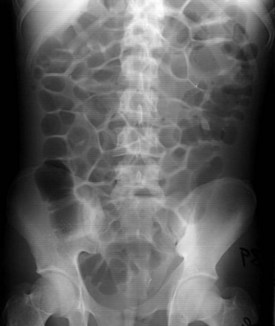24 Ileus
Ileus is defined as disruption of coordinated physiologic bowel motility owing to a nonmechanical cause.1 As a result, intestinal contents cannot progress through the gastrointestinal (GI) tract. The word ileus is derived from the Greek eileos, which means “twisting.” An ileus can develop as a primary process or as a result of a separate process that is usually associated with inflammation. The diagnosis of ileus must be differentiated from the diagnosis of mechanical bowel obstruction, since the latter condition also blocks the normal aboral progression of bowel contents but is due to the presence of an extrinsic or intrinsic anatomic barrier. These two conditions are treated differently.
 Clinical Features and Diagnosis
Clinical Features and Diagnosis
Radiographic studies are often obtained during the evaluation of patients with suspected ileus. Abdominal radiographs sometimes can be helpful for differentiating ileus from mechanical small bowel obstruction. The presence of gas in the stomach, small intestine, and colon (Figure 24-1) suggests ileus. In contrast, a paucity of gas within the abdomen, air/fluid levels within the small bowel, and absence of air within the colon suggest mechanical small bowel obstruction (Figure 24-2). A computed tomography (CT) scan with enteral contrast administration can better distinguish patients with ileus from those with mechanical bowel obstruction. Inspection of the abdominal CT scan often makes it possible to accurately localize a point of obstruction or a region of transition from dilated to decompressed bowel. If these findings are present, the diagnosis of mechanical bowel obstruction is established. Passage of oral contrast into the colon within 4 hours favors ileus over a bowel obstruction as the cause of intestinal dysmotility. The CT scan can also identify other intraabdominal inflammatory processes that can be the cause of ileus (e.g., appendicitis, pancreatitis, intraabdominal abscess).
< div class='tao-gold-member'>
Stay updated, free articles. Join our Telegram channel

Full access? Get Clinical Tree



